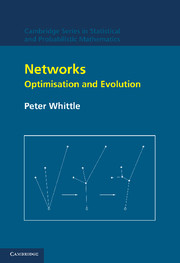Book contents
- Frontmatter
- Contents
- Acknowledgements
- Conventions on notation
- Tour d'Horizon
- Part I Distributional networks
- 1 Simple flows
- 2 Continuum formulations
- 3 Multi-commodity and destination-specific flows
- 4 Variable loading
- 5 Concave costs and hierarchical structure
- 6 Road networks
- 7 Structural optimisation: Michell structures
- 8 Computational experience of evolutionary algorithms
- 9 Structure design for variable load
- Part II Artificial neural networks
- Part III Processing networks
- Part IV Communication networks
- Appendix 1 Spatial integrals for the telephone problem
- Appendix 2 Bandit and tax processes
- Appendix 3 Random graphs and polymer models
- References
- Index
7 - Structural optimisation: Michell structures
Published online by Cambridge University Press: 23 November 2009
- Frontmatter
- Contents
- Acknowledgements
- Conventions on notation
- Tour d'Horizon
- Part I Distributional networks
- 1 Simple flows
- 2 Continuum formulations
- 3 Multi-commodity and destination-specific flows
- 4 Variable loading
- 5 Concave costs and hierarchical structure
- 6 Road networks
- 7 Structural optimisation: Michell structures
- 8 Computational experience of evolutionary algorithms
- 9 Structure design for variable load
- Part II Artificial neural networks
- Part III Processing networks
- Part IV Communication networks
- Appendix 1 Spatial integrals for the telephone problem
- Appendix 2 Bandit and tax processes
- Appendix 3 Random graphs and polymer models
- References
- Index
Summary
We come now to a most remarkable piece of work. This concerns the optimisation of load-bearing structures in engineering, such as frameworks consisting of freely jointed struts and ties – we give examples. The purpose of such structures is to communicate stress, a vector quantity, in an economic fashion from the points where external load is applied to the points where it can be off-loaded: the load-accepting foundation.
The problem of optimising such structures was considered in a paper, remarkable for its brevity and penetration as much as for its prescience, published as early as 1904 by the Australian engineer A. G. M. Michell. He derived the dual form of the problem and exhibited its essential role in determining the optimal design. This was at a time when there was no general understanding of the role or interpretation of the dual variable – Michell uses the concept of a ‘virtual displacement’, a term that we shall see as justified. He then went on to derive the continuous form of the dual, corresponding to the unrestricted optimisation of structures on the continuum. This opened the way to the study of structures made of material with directional properties (e.g. the use of resin-bonded fibre-glass matting in yacht hulls, the laying down of bone in such a way as to meet the particular pressures and tensions to which it is subjected). It also turned out to offer an understanding of materials that behave plastically rather than elastically under load – i.e. that yield catastrophically when load reaches a critical value.
- Type
- Chapter
- Information
- NetworksOptimisation and Evolution, pp. 95 - 115Publisher: Cambridge University PressPrint publication year: 2007

